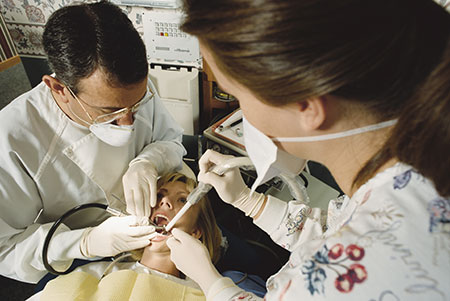Questions have been recently raised by some electrical contractors and designers in respect to electrical installations in dental offices per the CE Code. Let’s elaborate on potential surprises in conjunction with such installations.
At the first glance, a dental office is a space in a typical office building, and there should not be any specific concerns regarding electrical design and installation in such office space, as traditionally such design and installation would be limited to the wiring of lighting and receptacles in a typical office space.
However, after a close evaluation of this area, the designers and electrical contractors would realize that the electrical installation in a typical “innocent” looking dental office, where cord-connected dental equipment and specialty lighting equipment are used, would be covered by specific provisions of Section 24 of the CE Code, Part I.
Let’s take a look at the scope of Section 24 and at particular requirements of this Section:
“24-000 Scope (see Appendix B)
(1) This Section applies to the installation of (a) electrical wiring and equipment within patient care areas of health care facilities; and
(b) the portions of the electrical systems of health care facilities designated as essential electrical systems.
(2) Except as noted in Rules 24-104(7) and 24-108, this Section does not apply to installations of electrical communication systems as covered in Section 60, nor to radio and television installations as covered in Section 54.
(3) This Section supplements or amends the general requirements of this Code.”
Appendix B Note on Rule 24-000 states the following:
“Rule 24-000
This Section consolidates, in one section of this Code, requirements that arise from safety considerations that are unique to specific areas in health care facilities. It was compiled by the Technical Committee on Applications of Electricity in Health Care and the Committee on the Canadian Electrical Code, Part I, working in partnership. This Section no longer includes the original requirements affecting the use of flammable anaesthetics, as these anaesthetics are no longer used, but it continues to incorporate Rules designed to minimize the risks inherent in the use of electricity in patient care areas, as well as risks inherent in the interruption of a supply of electricity. The content of this Section has been modified to reflect the changing nature of health care. Procedures once reserved for hospitals are now performed in medical clinics. As such, this Section has been modified to apply to patient care areas of health care facilities, and its requirements are based on the care area (e.g., basic, intermediate, or critical). This approach is consistent with that taken in CSA Z32.”
It is interesting to note that Rule 24-002 “Special terminology” offers the following definitions related to patient care area:
“24-002 Special terminology (see Appendix B)
In this Section, the following definitions apply:
Basic care area — a patient care area where body contact between a patient and medical electrical equipment is neither frequent nor usual.
Body contact — an intentional contact at the skin surface or internally, but no direct contact to the heart.
Cardiac contact — an intentional contact directly to the heart by means of an invasive procedure.
Casual contact — contact by voluntary action with a device that has no applied part and is not intended to be connected to a patient.
Conditional branch — the portion of an essential electrical system in which circuits require power restoration by emergency service within 24 h, depending on special circumstances such as environmental or climatic conditions.
Critical care area — a patient care area that is an anaesthetizing location, or in which cardiac contact between a patient and medical electrical equipment is frequent or normal.
Delayed vital branch — the portion of an essential electrical system in which the circuits require power restoration within 2 min.
Emergency power system — a power system that is supplied from an emergency supply and connected to feed essential systems.
Emergency supply — one or more in-house generators of electricity intended to be available in the event of a failure of all other supplies and capable of supplying all the essential loads.
Essential electrical system — an electrical system that has the capability of restoring and sustaining a supply of electrical energy to specified loads in the event of a loss of the normal supply of energy.
Hazard index — for a given set of conditions in an isolated power system, the current, expressed in milliamperes and consisting of resistive and capacitive leakage and fault currents, that would flow through a low impedance if the low impedance were to be connected between either isolated conductor and ground.
Health care facility — a set of physical infrastructure elements that are intended to support the delivery of specific health-related services.
Intermediate care area — a patient care area in which body contact between a patient and medical electrical equipment is frequent or normal.
Patient care area — an area intended primarily for the provision of diagnosis, therapy, or care.
Patient care environment — a zone in a patient care area that has been pre-selected for the accommodation of a patient bed, table, or other supporting mechanism, and for the accommodation of equipment involved in patient treatment, and that includes the space within the room 1.5 m beyond the perimeter of the bed, table, or other supporting mechanism in its normal location and to within 2.3 m of the floor.
Patient care environment bonding point — a common bus, in a patient care environment, that is bonded to ground, and that serves as a common point to which equipment and other bonding connections can be made by means of a group of jacks.
Total hazard index — the hazard index of a given isolated system with all appliances, including the line isolation monitor, connected.
Vital branch — the portion of an essential electrical system in which the circuits require power restoration within 10 s”.
It is useful to note that Appendix B Note on Rule 24-000 references the CSA standard Z32. There is a very interesting description on application of this standard in the scope of Z32 and on its relationship with Section 24 of the CE Code (i.e., important information, which some users of the CE Code may not be aware of):
“1 Scope
1.1 General
1.1.1 Application
This Standard deals with the following subjects:
(a) electrical safety associated with health care provision; and
(b) essential electrical systems for health care facilities.
Note: See Clause 3 for the definition of “health care facility”.
1.1.2 Exclusions
1.1.2.1
This Standard is not intended to apply to veterinary facilities, although its electrical safety principles could prove useful in the design, construction, and operation of such facilities.
1.1.2.2
Uninterruptible power supplies, which can be essential for specific critical applications (e.g., critical care equipment and computer equipment), are not covered by this Standard.
1.1.3 Relationship to the Canadian Electrical Code, Part I
Provisions of this Standard are supplementary to the installation requirements specified in Sections 24 and 52 of the Canadian Electrical Code, Part I.”
Z32 also offers classifications of patient care areas as follows, and that based on this classification, a typical dental office (or dental clinic) is considered as “intermediate care area” in accordance with Clause 4.2.6.1(b)(vii) below:
“4.2.6 Patient care area classification
4.2.6.1 General
The administrator, clinical staff, and facility designers shall clearly define which types of procedures are to be frequently or normally performed in specified areas of the HCF. The area classifications shall be those specified in Section 24 of the Canadian Electrical Code, Part I, which are as follows:
(a) basic care area: a patient care area where body contact between a patient and medical electrical equipment is neither frequent nor usual. Examples include
(i) patient examination rooms;
(ii) patient rooms in a long-term care facility; and
(iii) patient rooms in general, specialty, and rehabilitation hospitals where body contact between a patient and medical electrical equipment is neither frequent nor usual;
(b) intermediate care area: a patient care area where body contact between a patient and medical electrical equipment is frequent or normal. Examples include
(i) wards and treatment and examination rooms in general, specialty, and rehabilitation hospitals;
(ii) renal dialysis units;
(iii) areas for non-invasive electrodiagnosis (ECG, EEG, EMG);
(iv) patient preparation areas;
(v) physiotherapy departments;
(vi) ultrasound suites;
(vii) dental clinics;
(viii) chiropractic clinics;
(ix) physicians’ offices; and
(x) patient bedrooms; and
(c) critical care area: a patient care area where the induction and maintenance of general anaesthesia routinely occurs in connection with the examination or treatment of patients, or where cardiac contact between a patient and medical electrical equipment is frequent or normal. Examples include
(i) angiographic laboratories;
(ii) cardiac catheterization laboratories;
(iii) cardiac care units;
(iv) emergency trauma units;
(v) intensive care units;
(vi) intensive care neonatal units;
(vii) operating rooms; and
(viii) burn units”.
This means that general provisions of Section 24 of the CE Code, Part I for bonding in patient care area and for installation of receptacles in patient care area would have to be further “beefed up” by additional requirements of Rules 24-110 – 24-114 in respect to installation of receptacles and branch circuits, and for bonding to ground in intermediate care area:
“24-110 Circuits in intermediate and critical care areas (see Appendix B)
The branch circuits supplying receptacles or other permanently connected equipment in intermediate or critical care areas shall be supplied from either a grounded system meeting the requirements of Rule 24-102 or an isolated system meeting the requirements of Rule 24-200, except that all branch circuits supplying loads within patient care environments, other than those supplying multiphase equipment, shall be 2-wire circuits.
24-112 Bonding to ground in intermediate and critical care areas (see Appendix B)
(1) Bonding to ground in intermediate and critical care areas shall conform to Rule 24-104 whether the supply is derived from a grounded or an isolated system.
(2) If a patient care environment bonding point is provided, it shall be bonded to the panelboard serving the patient care environment with which it is associated by either
(a) a bonding jumper connecting it to the bonding terminal in an enclosure that accommodates the bonding point along with receptacles for a patient care environment; or
(b) a copper conductor that is installed for that specific purpose and is run in the same raceway as the equipment bonding conductors serving that patient care environment.
24-114 Receptacles in intermediate and critical care areas (see Appendix B)
Receptacles in intermediate and critical care areas shall
(a) meet the requirements of Rule 24-106; and
(b) where supplied from an isolated system, be identified as such”.
It should be noted that some electrical designers and installers who are not aware that Z32 supplements Section 24 of the CE Code, and who are not aware that Z32 classifies a simple dental office as intermediate care area of a health care facility, and as such places very formidable requirements for electrical installations in a typical dental office, could be surprised and puzzled when their design and installation would be rejected by the electrical safety regulators.
It should be also noted that some AHJs may not necessarily adopt Z32 for mandatory use in their jurisdictions, but in accordance with a good engineering practice this fact does not mean that technical provisions of Z32 could be (and should be) disregarded by the CE Code users.
This little article illustrates a need for a careful examination of all relevant standards which might impact on the electrical installation in health care facilities and on application of electrical safety and on understanding of essential electrical systems in health care facilities.
As usual, electrical safety regulators should be contacted to discuss application of Z32 in conjunction with electrical installations in dental offices.















Find Us on Socials